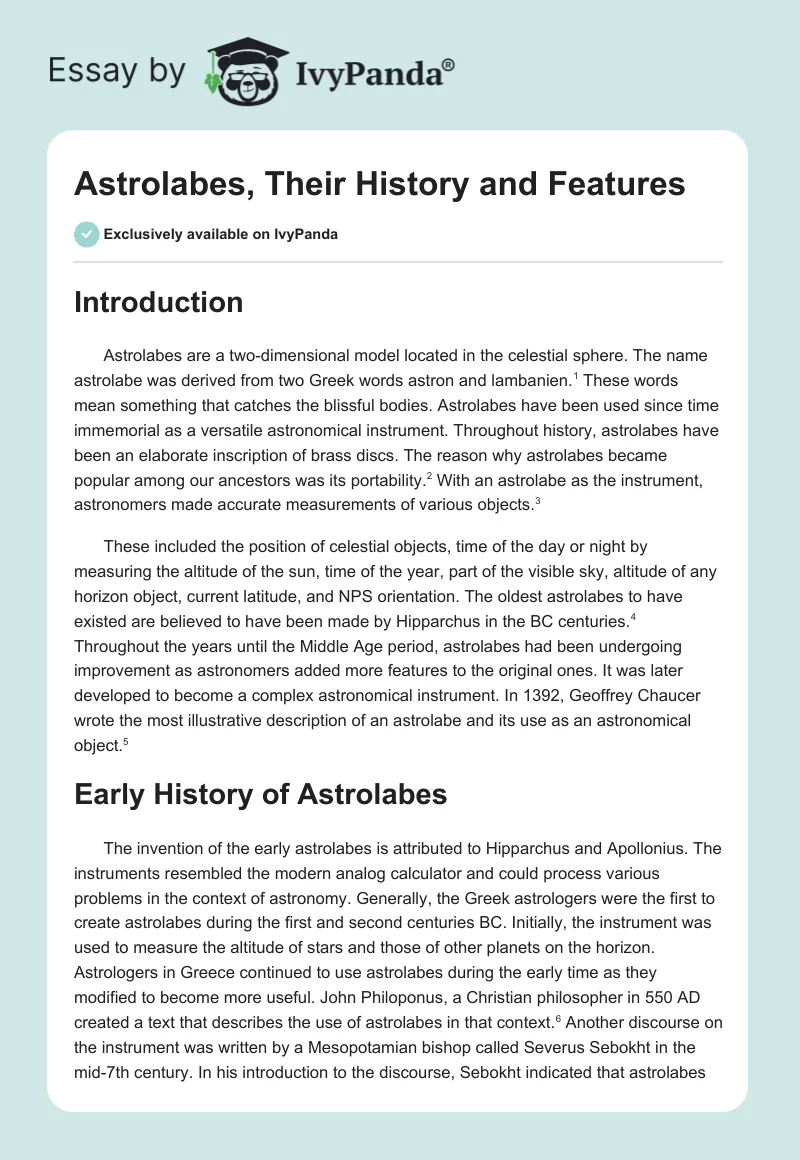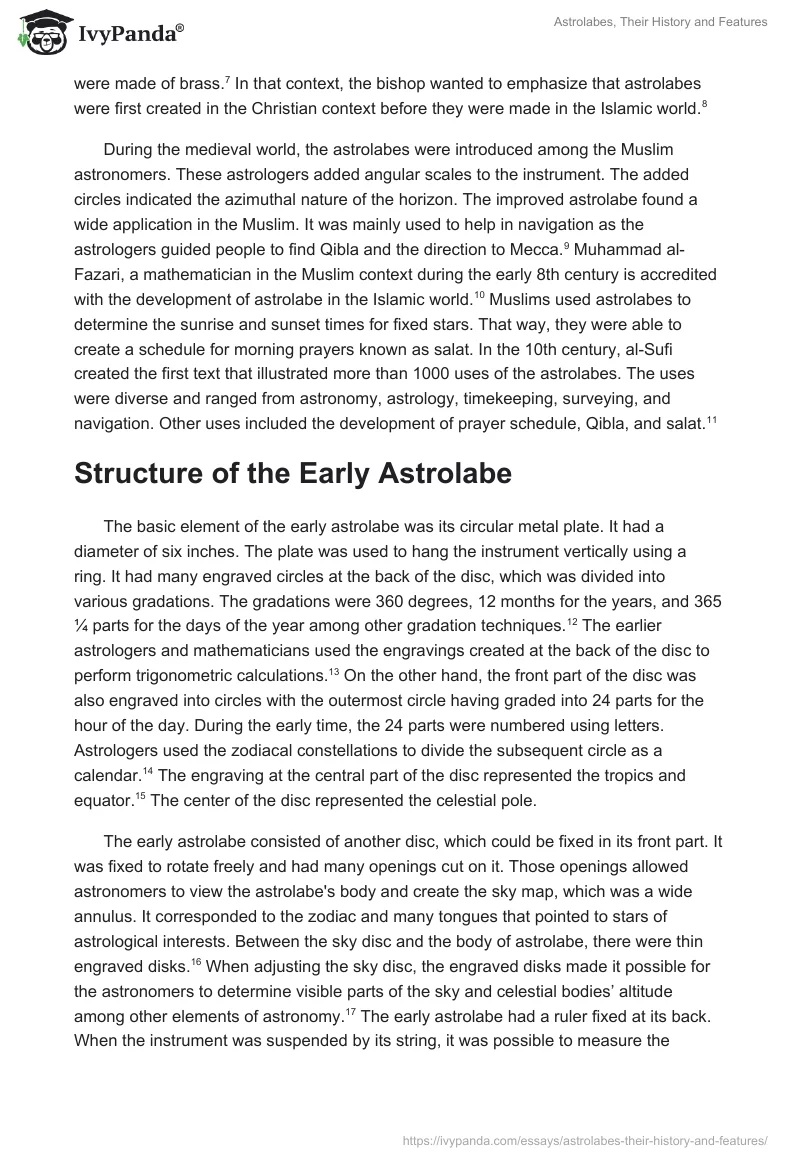Introduction
Astrolabes are a two-dimensional model located in the celestial sphere. The name astrolabe was derived from two Greek words astron and lambanien. These words mean something that catches the blissful bodies. Astrolabes have been used since time immemorial as a versatile astronomical instrument. Throughout history, astrolabes have been an elaborate inscription of brass discs. The reason why astrolabes became popular among our ancestors was its portability. With an astrolabe as the instrument, astronomers made accurate measurements of various objects.
These included the position of celestial objects, time of the day or night by measuring the altitude of the sun, time of the year, part of the visible sky, altitude of any horizon object, current latitude, and NPS orientation. The oldest astrolabes to have existed are believed to have been made by Hipparchus in the BC centuries. Throughout the years until the Middle Age period, astrolabes had been undergoing improvement as astronomers added more features to the original ones. It was later developed to become a complex astronomical instrument. In 1392, Geoffrey Chaucer wrote the most illustrative description of an astrolabe and its use as an astronomical object.
Early History of Astrolabes
The invention of the early astrolabes is attributed to Hipparchus and Apollonius. The instruments resembled the modern analog calculator and could process various problems in the context of astronomy. Generally, the Greek astrologers were the first to create astrolabes during the first and second centuries BC. Initially, the instrument was used to measure the altitude of stars and those of other planets on the horizon. Astrologers in Greece continued to use astrolabes during the early time as they modified to become more useful. John Philoponus, a Christian philosopher in 550 AD created a text that describes the use of astrolabes in that context. Another discourse on the instrument was written by a Mesopotamian bishop called Severus Sebokht in the mid-7th century. In his introduction to the discourse, Sebokht indicated that astrolabes were made of brass. In that context, the bishop wanted to emphasize that astrolabes were first created in the Christian context before they were made in the Islamic world.
During the medieval world, the astrolabes were introduced among the Muslim astronomers. These astrologers added angular scales to the instrument. The added circles indicated the azimuthal nature of the horizon. The improved astrolabe found a wide application in the Muslim. It was mainly used to help in navigation as the astrologers guided people to find Qibla and the direction to Mecca. Muhammad al-Fazari, a mathematician in the Muslim context during the early 8th century is accredited with the development of astrolabe in the Islamic world. Muslims used astrolabes to determine the sunrise and sunset times for fixed stars. That way, they were able to create a schedule for morning prayers known as salat. In the 10th century, al-Sufi created the first text that illustrated more than 1000 uses of the astrolabes. The uses were diverse and ranged from astronomy, astrology, timekeeping, surveying, and navigation. Other uses included the development of prayer schedule, Qibla, and salat.
Structure of the Early Astrolabe
The basic element of the early astrolabe was its circular metal plate. It had a diameter of six inches. The plate was used to hang the instrument vertically using a ring. It had many engraved circles at the back of the disc, which was divided into various gradations. The gradations were 360 degrees, 12 months for the years, and 365 ¼ parts for the days of the year among other gradation techniques. The earlier astrologers and mathematicians used the engravings created at the back of the disc to perform trigonometric calculations. On the other hand, the front part of the disc was also engraved into circles with the outermost circle having graded into 24 parts for the hour of the day. During the early time, the 24 parts were numbered using letters. Astrologers used the zodiacal constellations to divide the subsequent circle as a calendar. The engraving at the central part of the disc represented the tropics and equator. The center of the disc represented the celestial pole.
The early astrolabe consisted of another disc, which could be fixed in its front part. It was fixed to rotate freely and had many openings cut on it. Those openings allowed astronomers to view the astrolabe’s body and create the sky map, which was a wide annulus. It corresponded to the zodiac and many tongues that pointed to stars of astrological interests. Between the sky disc and the body of astrolabe, there were thin engraved disks. When adjusting the sky disc, the engraved disks made it possible for the astronomers to determine visible parts of the sky and celestial bodies’ altitude among other elements of astronomy. The early astrolabe had a ruler fixed at its back. When the instrument was suspended by its string, it was possible to measure the altitude of the celestial bodies. Astrologers could point at the body with the ruler and read the measurement of one of the engraved circles.
Astrolabes in the Muslim World
The introduction of astrolabes in the Islamic world occurred in the mid-8th century. From then on, the instrument was gradually developed and improved. The Arab discourse on astrolabes was published in the 9th century. The oldest existing astrolabe in the Muslim context was made in the mid-10th century. From them to the early 12th century, more than 40 astrolabes with improved features had been made in the 12th century. The reason why Muslims valued astrolabes was its capacity for determining prayer times using astronomic features. Also, Muslims used the instrument to find their way to Mecca, an occurrence they referred to as the Qibla.
The fact that astrology was deeply embedded in the Muslim culture made the astrolabe a valuable cultural tool. Muslim astrologers made the Persian astrolabes, which were more complex in terms of its artisanship compared to the earlier ones. The instrument was created with stylistic elements that made them unique and different from those made by the eastern Muslim astrologers and Northern African astrologers as well as the Al-Andalus of Moorish Spain. The Mughal Indians used the astrolabes in a more illustrative way.
Astrolabes in Europe
Peter of Maricourt developed discourse about the creation and usage of the universal astrolabes during the early second half of the 13th century. During the late 14th century, an English author called Geoffrey developed a text on the astrolabes that he created for his son. The first published book about the astrolabes was written by Christian of Prachatice in his work titled “Composition and Use or Astrolabes”. In the late 14th century, Mahendra Suri, a Jain astronomer was the first to develop a treatise on astrolabes in the Indian context. On the other hand, the first known astrolabe made of metal in Western Europe was called the Destombles. It was a Spanish astrolabe made of brass during the 10th century.
From the Greek context, astrolabes moved to the Muslim world and penetrated the Arab countries in the Middle East and North Africa region. In Europe, astrolabes appeared with the help of Christian monasteries. Spain became the first European country to adopt the astrolabe, which was referred to as the Al-Andalus. The information about astrolabes is believed to have been introduced in the European context in the early 11th century. However, the widespread’ of its usage occurred during the 13th and 14th centuries. The first astrolabes to be used in Europe were imported from Moslem Spain. The astrolabes were engraved using Latin words as well as Arabic words to show that they originated from the Muslim context. It can be argued that the use of Arabic names for the stars in Europe was influenced by the Muslim origin of astrolabes.
By the end of the 12th century, more than six treatises written in Latin about astrolabes had been published. Also, hundreds of such treatises were available in the subsequent century. The astrolabe creators in the European context expanded the plate engravings to include information about astrology. Also, they adopted different timekeeping variations during those eras. The instruments made by the European astrologers did not include the features related to the Islamic prayers.
The late Middle Age and the Renaissance periods were popular with an astrolabe in Europe. The popularity of the instrument was noted from the 15th century to the 16th century. Astronomy was considered a fundamental aspect of education. Therefore, the skills of using astrolabe were a sign of appropriate development in education. Europeans used astrolabe for astrological purposes. During the 15th century, the major manufacturing countries were Spain, Germany, France, and Belgium among others.
Astrolabes to the Modern World
The use of astrolabes in the astronomical context and cultural practices decreased in the late 17th century. The main contributing factor for its decline is the invention of a pendulum clock, which was more reliable than the astrolabes. The pendulum clock was a more specialized scientific instrument with a high degree of accuracy. Other devices such as the telescope were also made available for astrological use. However, the Arab world continued to create astrolabes until the 19th century. In the contemporary world, astrolabes do not serve any important purpose. They are only made for fun and as a way of keeping their historical importance alive. Also, the education system still appreciates the great value of astrolabes in the development of skills.
Conclusion
Astrology has strongly influenced the historical development of astronomy. The ancient astronomers managed to determine the position of stars and other planets on the horizon. They tracked eclipses and observed celestial objects for astrological reasons. The Greek astrologers were the first to invent the astrolabe. The instrument became the most important tool for astrologers in the Greek context. Later, the Islamic world adopted astrolabes before spreading across Europe.
References
“Astrolabe History.” Astrolabe History. Web.
Gunella Alessandro, John Lamprey, and James E. Morrison. “Stoeffler’s Elucidatio: The Construction and Use of the Astrolabe.” Aestimatio: Critical Reviews in the History of Science 4 (2015): 155-161.
Ḥasan, Aḥmad Yūsuf, Maqbul Ahmed, and Ahmad Iskandar. Science and technology in Islam. Paris: UNESCO Publisher, 2001.
Hoskin, Michael. The Cambridge illustrated history of astronomy. London: Cambridge University Press, 1996.
Northrup, Cynthia. Encyclopedia of world trade: from ancient times to the present. New York: Routledge. 2015.
Safiai, Mohd Hafiz et al. “The Continuity of Astrolabe as a Multipurpose Astrofiqh Instrument.” International Journal of Applied Engineering Research 11, no. 9 (2016): 6081-6086.
Selin, Helaine, and Xiaochun Sun. Astronomy across cultures: the history of non-Western astronomy. Dordrecht: Kluwer Academic Publishers, 2012.
Vondrák, Jan. “History of Monitoring Earth Orientation, and Re-analyses of Old Data.” The International Association of Geodesy Symposia 9, no. 1 (2016): 1-9.


